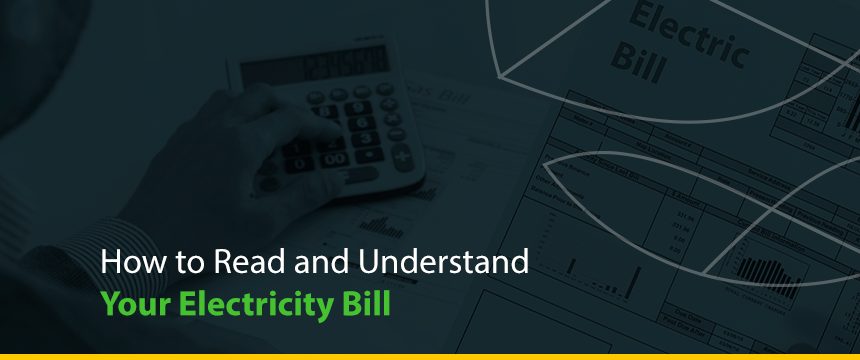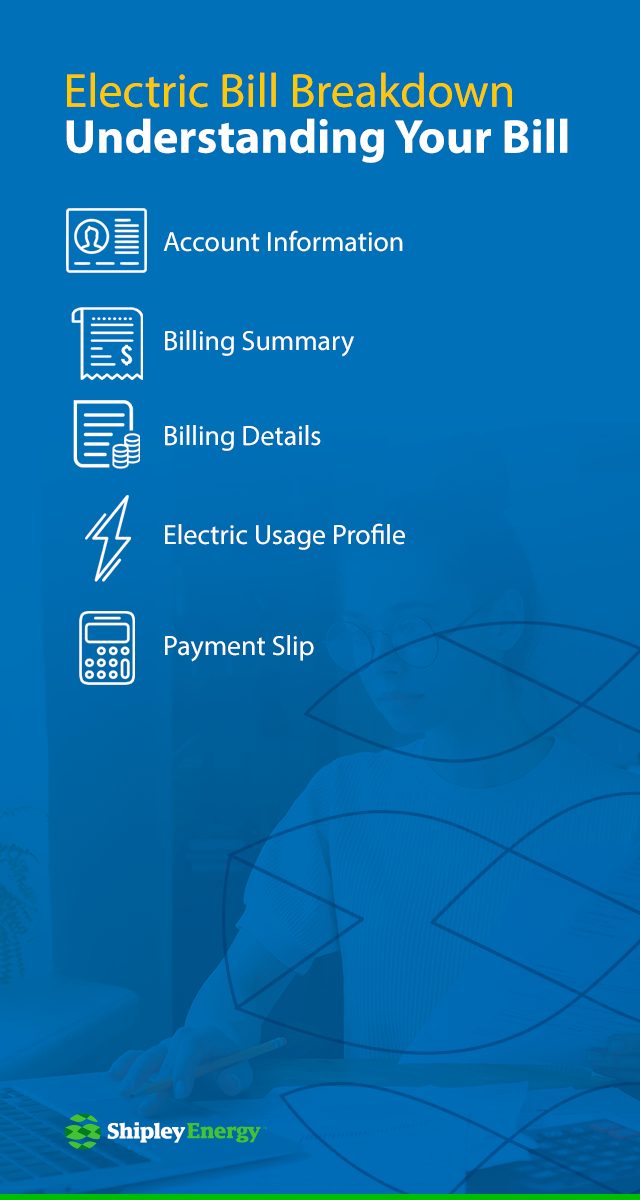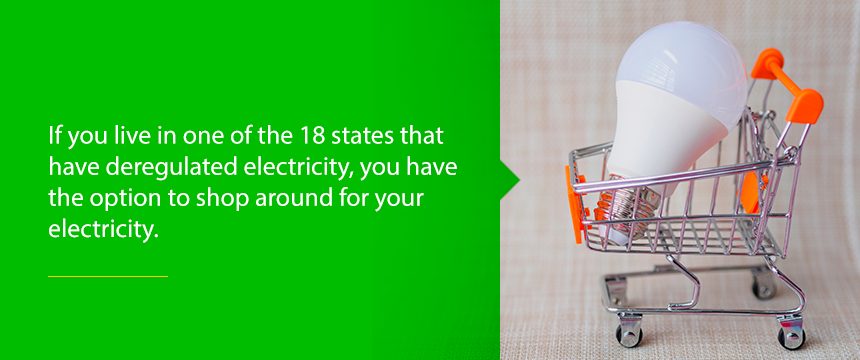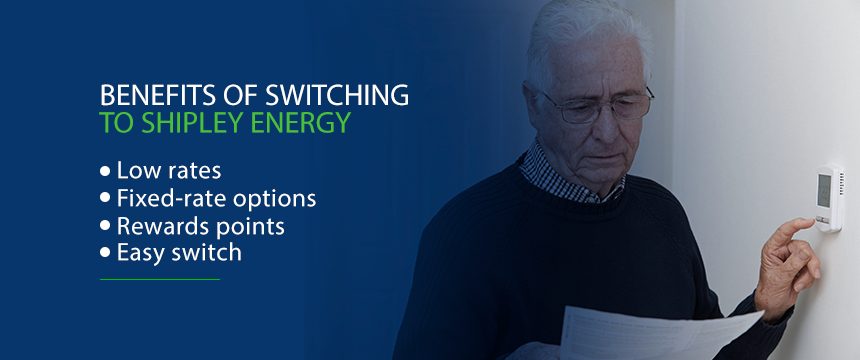

If you’ve ever looked at your electricity bill and wondered what everything on it means, then this article is for you. Electricity bills can be complicated at first glance, but we’re here to demystify them and explain how to understand your electric bill. A better understanding of your electric bill can help you become a more informed consumer and possibly help you save money on your utilities.
There is no standard format for all electric bills, so your bill and your friend’s in the next city over may look a bit different. That said, most electric bills include the same types of information and group them into similar sections. These sections include your account information, billing summary, billing details, electric usage profile, and a payment slip for paying your bill by mail. Let’s take a closer look at each of these sections so you can have a better idea of how to read your electricity bill.

Your bill should include a section, probably near the top, that covers basic information, including your name, account number, address and phone number. This information should be the same on every bill. It’s just a way to confirm that the bill is intended for you, and it can serve as an easy reference if you need to request customer support since you’ll need to provide your account number.
The billing summary is the section you’re likely used to focusing on. This section provides an overview of your current charges, your total account balance and when your payment is due. This section is fairly straightforward, so it’s a helpful point of focus if all you’re concerned with is paying your bill. If you want to understand more about what exactly you’re being charged for, you should look at the billing details section.
Your billing details provide a breakdown of your total monthly charges. This information can be helpful if you understand what each line item means. Here are some of the individual charges that will add up to the total in your billing summary:
Your electric usage profile summarizes how much electricity you consumed over the current billing cycle and gives an overview of your consumption history over the last several months or year. This information can help you get an idea of how much energy you’re using month to month and how your energy consumption this year compares to your consumption from the same time last year. This section is usually divided into a text section and a graph.
The text will usually list the amount of electricity, measured in kilowatt-hours (kWh), you used during the current month, the amount you used last month, and the amount you used during the current month last year. Your bill may even provide more details, such as the average outdoor temperatures during these months since that can impact the demand you place on your HVAC system — which tends to be responsible for a large portion of your energy consumption.
The bar graph typically includes all 12 months, either in order from January to December or starting one year ago and ending in the current month. These graphs will use bars to show how much electricity you used each month. It may include an additional bar for each month that represents your consumption during that same month last year. Seeing this year’s and last year’s bars right next to each other provides a convenient visual comparison.
The payment slip is the portion at the bottom of your bill that you would detach if you plan to pay your bill by mail. This portion of the bill may also list the ways you can pay your bill, which typically includes one-time payments or automatic payments online, as well as paying by check through the mail. You only ever need to pay your utility company, even if you have chosen a different supplier for your electricity. This keeps your bill payment simple.
One thing many consumers want to know is what is the average electric bill. This is usually so they can compare their own bill to this average.
The cost you pay for electricity each month largely depends on how much electricity you consume. Aside from the additional minor charges on your bill, you can determine how much you’ll spend on electricity by multiplying the number of kilowatt-hours you consume over a month by the cost per kilowatt-hour that your utility company or supplier charges. In some cases, this cost will vary over time, but if you have a fixed-rate plan, it will remain consistent over the course of your contract.
There are many factors that can influence how much electricity you use. Some of these factors include where you live, the size of your home and the types of appliances you use. For instance, a person who lives alone in a small apartment in a mild climate will likely use a lot less electricity than a big family in a large house with major demands on the HVAC system to maintain a comfortable temperature.
Even two identical families in identical houses in the same place will likely use different amounts of electricity based on their lifestyle and habits. That said, you can look at averages to get an idea of the total most families see on their electric bill each month.
The average monthly electricity bill in the U.S. was $117.65 in 2018, according to the U.S. Energy Information Administration (EIA). The EIA also provides a monthly average for each state, with Utah being the lowest at $77.25 and Hawaii being the highest at $168.13. These averages can give you a general idea of what you should expect to pay for electricity each month, but for most people, their bill will vary from month to month as daylight hours wax and wane and as the temperature outside rises and falls.
This is where your user profile can help you see how your electricity usage this month compares to the same time last year. Once you’ve lived in the same place for a while, you can use your own records to get an accurate idea of how much you should budget for electricity each month throughout the year. This is a more effective approach than referencing averages for the country or for your state.
If you live in one of the 18 states that have deregulated electricity, you have the option to shop around for your electricity. This means that, while you will still receive your electricity bill from your region’s utility distribution center, your electricity itself will be supplied by a different company. These other companies are often getting electricity from the same generation stations as your utility provider, but they may offer it to you at a better price.

A deregulated electricity market encourages competition and can ultimately save you money. Residents in Pennsylvania who have taken advantage of the deregulated market and chosen a least-expensive supplier available rather than their utility company save an average of $10 per month. Even a seemingly tiny difference in price could save you a lot of money over time. Considering that the average American household uses 10,972 kWh hours in a year, even just one cent less per kWh could easily save you over $100 a year.
Choosing a different supplier rather than your utility company can also open up other benefits like fixed-rate plans or better customer service. Plus, switching suppliers is an easy process. It doesn’t require you to get any new equipment, and it won’t cause a disruption in service. For many customers, it’s as simple as a single phone call or online contract.
Just as with other products and services you purchase, there are plenty of reasons to shop around rather than settle for the default option when it comes to electricity. If you live in a regulated state, join efforts to have your state deregulated so you can cash in on these benefits.
If you’re looking at your electricity bill, you may see a line that tells you what your “price to compare” (PTC) is. This isn’t very helpful if you’re not sure what PTC means. Fortunately, the explanation is fairly simple. This number is the price per kilowatt-hour that your utility company or supplier charges. In some cases, this price will include taxes or other fees, but often, these costs are listed separately. Your generation charge in the billing details should be the result you get from multiplying the number of kilowatt-hours you used by the PTC.
The PTC is useful if you’re shopping around for electricity because, as the term suggests, it allows you to directly compare rates from different suppliers. See what your utility company’s PTC is, and then look at various suppliers in your area to see if you can find a better rate. Keep in mind that the PTC can fluctuate seasonally, with prices typically being highest in the summer. If you would prefer a constant rate, you should consider a fixed-rate contract with a supplier like Shipley Energy.
Shipley Energy is an electricity supplier who has our customers’ best interest at heart and is happy to bring you valuable benefits you may not get from your local utility company. Some of these benefits include:

For over 90 years, Shipley Energy has been providing energy to homes and businesses in our region. Today, in addition to our many other energy services, we supply electricity at affordable rates to homes in Pennsylvania, Ohio, and Maryland. If you’re interested in having Shipley Energy become your electricity supplier, take a moment to learn more about our residential electricity rates. You can check rates online or contact us directly to learn more.
